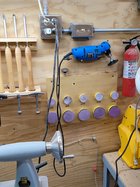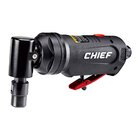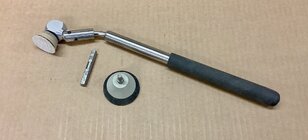Everyone has to do sanding before applying finishes. I am interested in not only what is your primary sander e.g. battery powered drill, corded drill, or inertia sander, etc. but also, if you have experimented with different types of sanders, how did you choose your go to tool?
-
December 2025 Turning Challenge: Single Tree! (click here for details) -
Congratulations to Bob Henrickson, People's Choice in the November 2025 Turning Challenge (click here for details) -
Congratulations to Guillaume Fontaine for "Old Tea Pot" being selected as Turning of the Week for December 15, 2025 (click here for details) -
Welcome new registering member. Your username must be your real First and Last name (for example: John Doe). "Screen names" and "handles" are not allowed and your registration will be deleted if you don't use your real name. Also, do not use all caps nor all lower case.
You are using an out of date browser. It may not display this or other websites correctly.
You should upgrade or use an alternative browser.
You should upgrade or use an alternative browser.
sander preference
- Thread starter Larry Mercier
- Start date
I took one look at the inertial sanders and said no because I couldn't sand with the bowl not spinning. I went with a Milwaukee angle drill from back when they used to be made by Sioux Tools. I did get one of the Milwaukee drills after Milwaukee started making their own. Keys to longevity with the corded drills is to run at half speed max, oh, with the slow speed drills, and never more than the weight of the drill for pressure. They are drills, and not grinders, which is pretty much what we use them for. As for the cordless drills, I tried one once. The battery would last 2 bowls or so, then would need to be recharged, which means that I would need several batteries. Just didn't like them. Still trying to figure out how to do a flex shaft from a mini lathe with forward and reverse, and have that mounted on my 'articulated arm for bowl sanding', and I have a video on that. Got the flex shaft from King Arthur tools, I think. There are several right angle drill attachments that should work...... Hand sanding, nope, just not efficient. I can get 500+ bowls from the drills before they need new bearings, and some times brushes. I did try one of the 'cheap' ones once and it had problems with the trigger after only a few bowls. I tried a pneumatic one, and it kept the compressor running non stop. The smaller Grex sanders, pneumatic, do work, and some use them, but I found they work better with the finer grits, like above 220, but not with the coarser grits. Some times I do start with 80 grit, but that depends more on the wood than anything else... They are random orbit sanders.
robo hippy
robo hippy
Inertia sanders seem quite popular. They are easy to make or fairly cheap to buy. Easy to use but not fast. Personally I quite like using them.
I did see a post on social media where a guy said they were a complete waste of time. He didn’t initially elaborate on why. When questioned he admitted that as professional turner he didn’t have time to use one, so he used a battery drill as a sander. Some asked why a professional turner was wasting his time posting on social media if his time was so short …
I did see a post on social media where a guy said they were a complete waste of time. He didn’t initially elaborate on why. When questioned he admitted that as professional turner he didn’t have time to use one, so he used a battery drill as a sander. Some asked why a professional turner was wasting his time posting on social media if his time was so short …
Odie
Panning for Montana gold, with Betsy, the mule!
For external sanding on my bowls, I only sand by hand, starting at no coarser than 180gt. Many times I can start sanding a tooled surface with finer grits than that.....240gt, or even higher at times.
However, I still do rely on power sanding for bowl interiors. For this, I will only use the Milwaukee 55° corded drills. (Sioux is good too....when you can find them.) Although I've completely worn out 5-6 of them over the past 42 years, I've come to appreciate them for being "industrial grade"......and, the abuse they get from me is horrible, compared to the kind of use they were intended for within the construction trades.
-o-
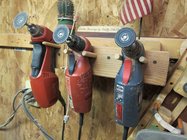
However, I still do rely on power sanding for bowl interiors. For this, I will only use the Milwaukee 55° corded drills. (Sioux is good too....when you can find them.) Although I've completely worn out 5-6 of them over the past 42 years, I've come to appreciate them for being "industrial grade"......and, the abuse they get from me is horrible, compared to the kind of use they were intended for within the construction trades.
-o-

Last edited:
Steve Worcester
Admin Emeritus
I do not like inertia sanders because the speed of the sanding disk is dependent on the surface feet per minute of the piece you are working on. Regardless of the speed, the smaller the diameter is, the slower the disk goes. This maybe related to why I do not like hand sanding. Maybe it is the heat maybe it is the concentric rings on the piece. But if you stop and sand against those rings, it wouldn't be that bad.
I have had several Sioux electrics, love them, then they had a bad batch of drills that used non-metallic bearings and the woodturning community melted them and maybe that is why, or maybe not, Sioux doesn't make electric drills.
I have other electric right angle drills that I buy just for the research, like Pep boys or Harbor Freight, they all work about the same, they work but I think for what we do, they are designed to be disposable. They aren't quiet, which is why I don't use them much, a bonus would be if they had a keyless chuck, just less hassle and one thing less to lose.
My current cordless is a Milwaukee 2438. It has a really obscure thread on the nose (9.5 mm) but it is easy to rethread to 1/4x20. The batteries are readily available and an extended battery is not horribly expensive (Milwaukee brand)
But, most all of the cordless tool brands can fit this model - and it doesn't have to be a right angle or compact depending on the internal size of the vessel. If you have a brand you are in to, look at what drills they have. You don't want it to spin too fast, which is one of the problems with pneumatic tools like angle grinders or drills. Speed and or pressure on the disk equals heat. Heat is the enemy of sanding.
I have had several Sioux electrics, love them, then they had a bad batch of drills that used non-metallic bearings and the woodturning community melted them and maybe that is why, or maybe not, Sioux doesn't make electric drills.
I have other electric right angle drills that I buy just for the research, like Pep boys or Harbor Freight, they all work about the same, they work but I think for what we do, they are designed to be disposable. They aren't quiet, which is why I don't use them much, a bonus would be if they had a keyless chuck, just less hassle and one thing less to lose.
My current cordless is a Milwaukee 2438. It has a really obscure thread on the nose (9.5 mm) but it is easy to rethread to 1/4x20. The batteries are readily available and an extended battery is not horribly expensive (Milwaukee brand)
But, most all of the cordless tool brands can fit this model - and it doesn't have to be a right angle or compact depending on the internal size of the vessel. If you have a brand you are in to, look at what drills they have. You don't want it to spin too fast, which is one of the problems with pneumatic tools like angle grinders or drills. Speed and or pressure on the disk equals heat. Heat is the enemy of sanding.
For roughing
Sioux 1400rpm angle drill
Milwaukee M12 rotary sander-polisher 0-2800 rpm
For finishing inside and out
Festoool 125EC_EQ 5" random orbit max 10k rpm
Grex angle random orbit sander max 10k rpm used throttled down
Random orbit sanders are less aggressive but better for fine grits due to the random scratch pattern.
Sioux 1400rpm angle drill
Milwaukee M12 rotary sander-polisher 0-2800 rpm
For finishing inside and out
Festoool 125EC_EQ 5" random orbit max 10k rpm
Grex angle random orbit sander max 10k rpm used throttled down
Random orbit sanders are less aggressive but better for fine grits due to the random scratch pattern.
Last edited:
Thanks to all for sharing your thoughts on sanding tools. You were helpful.
Odie
Panning for Montana gold, with Betsy, the mule!
I have had several Sioux electrics, love them, then they had a bad batch of drills that used non-metallic bearings and the woodturning community melted them and maybe that is why, or maybe not, Sioux doesn't make electric drills.
Interesting, Steve......
I no longer have any of the Sioux 55° angle drills I had. I think there were two of them. and they both have been retired. Off hand, I don't remember why they were retired, but of those that have, including the Milwaukee drills, the reasons for retiring them have mostly been bearings wearing out.
-o-
I use an air sander. They are about $35-50 on Amazon. Why air? I just always wanted one.  In hindsight, though, it's loud. I always wear ANC ear buds when sanding so it's not that big a deal. I have just ordered a second air sander and an electric angle drill. I want to compare the air to electric. Plus, with three sanders, I don't have to worry about changing mandrels from 3" to 2" and back again. Call me lazy.
In hindsight, though, it's loud. I always wear ANC ear buds when sanding so it's not that big a deal. I have just ordered a second air sander and an electric angle drill. I want to compare the air to electric. Plus, with three sanders, I don't have to worry about changing mandrels from 3" to 2" and back again. Call me lazy.
I arrived at my main chosen tool, corded close 1/4 drill, through the process of elimination. Inertia are dependent on surface speed, and useless for spot/area sanding. Battery op is too expensive (need several batts). Air sanders just use too much air, requiring an oversized compressor.
My 2nd favorite is a relatively small var speed automotive polisher that becomes an ros with the right mandrels. Mainly used with higher grits, to remove scratches from the previous grit.
My 2nd favorite is a relatively small var speed automotive polisher that becomes an ros with the right mandrels. Mainly used with higher grits, to remove scratches from the previous grit.
I bought a Souix angle drill 25-30 years ago and used it for several years, tried rebuilding when bearings went out but that didn't work out well (don't recall why). Since then I've bought the cheap HF knockoffs, they seem to last as long as the Souix did; I've burned through one and have two now (one 3", one 2") and one of those is probably getting on it's last legs. I no longer use these as much since getting a pneumatic from WoodturningWonders a year or so ago. Now I just use the electric angle drills for any course sanding needed (up to 220) and use the pneumatic for 220 and above. Hand sanding has it's place too. I still sand too much but the good news is that as I've gained skills at sharpening and use of my tools I sand **way** less than I did when I burnt out that original Souix 
I used air tools when I worked as a mechanic. Fine in summer but jeez were they cold on your hands in winter!I use an air sander. They are about $35-50 on Amazon. Why air? I just always wanted one.In hindsight, though, it's loud. I always wear ANC ear buds when sanding so it's not that big a deal. I have just ordered a second air sander and an electric angle drill. I want to compare the air to electric. Plus, with three sanders, I don't have to worry about changing mandrels from 3" to 2" and back again. Call me lazy.
I use an air sander. They are about $35-50 on Amazon. Why air? I just always wanted one.In hindsight, though, it's loud. I always wear ANC ear buds when sanding so it's not that big a deal. I have just ordered a second air sander and an electric angle drill. I want to compare the air to electric. Plus, with three sanders, I don't have to worry about changing mandrels from 3" to 2" and back again. Call me lazy.
I got my electric angle drill the other day. I haven't been able to test it out on a bowl yet, but I did sand the bottom of a couple. On first impression the electric sander is WAY more grabby than the pneumatic. That's due to the slow speed, I assume. That should also mean it's working better than the air sander I have been using. I'm eager to take one of my once-turned natural edge bowls and sand it from start to finish with the electric. I hope it's a revelation. Could be the air sander is just too fast and I've been wasting time using it. I can slow it down, but then it bogs down immediately. Anyway, I'll report back once I have some time with the electric sander.
As a hobby turner, I just sand by hand. I use 3" Klingspor J-weight cloth rolls (about as flexible as new denim jeans), 120 to about 600. I sand forward and reverse. I also keep a rubber sandpaper cleaner block next to the lathe to clean the paper. If needed, I grab a piece of the rubbery foam stuff used to pack boxes for computers and similar, and use it as a backer for the paper. When I'm done sanding to the grit that seems to give the surface I need, then I grab a handful of shavings and buff/burnish the surface of the wood.
I have a Sorby inertia sander- pfft. I should just toss it. I have used a 5" ROS on the outside of a bowl with 120 then 220 grit.
I have a Sorby inertia sander- pfft. I should just toss it. I have used a 5" ROS on the outside of a bowl with 120 then 220 grit.
I took Steve Worcester's advice about 20-years ago and bought AirVantage pneumatics from Bruce Hoover, aka The Sanding Glove - haven't looked back - still using the original two. They are expensive but less than half the price of Dynabrade. The lightness and 3/32" orbit are perfect when coupled with silicon carbide.
I use the sander with paper-backed silicon carbide to remove orange-peel and then go to hand sanding which I find both faster and more uniform.
I use the sander with paper-backed silicon carbide to remove orange-peel and then go to hand sanding which I find both faster and more uniform.
I use the same sander and have been very satisfied.I went with the complete system from Woodturres Wonders because it fit my budget at the time. I have been very happy with it and would buy it again.
View attachment 60260
me, too, but often a longer mandrel.I use the same sander
I'm surprised no one here has mentioned the good ol' Harbor Freight right angle drills. I love them. In 25 years of turning I'm on my fourth one. My first two were the orange ones with the keyed chuck, then a blue one with the keyless chuck, and now a red one with a keyed chuck. They change the brand name every few years, make them in different colors, but when you tear them down they're all the exact same inside. When the bearings start wearing out, they sand even better with a little wobble. But I push them til they won't go any farther. I just can't make myself buy a $80-100+ drill just to ruin it with dust. And dust will kill them all. Watch for the sales and coupons and buy a couple while their cheap(er). Save your money and spend it on good quality sandpaper, change it often, don't skip grits.
Me too. I have three of their old style, corded, right angle drills, with 1", 2", and 3" mandrels installed. Kind of like having enough chucks so you don't have to change jaws. My oldest is 12 years old and still going strong.I'm surprised no one here has mentioned the good ol' Harbor Freight right angle drills. I love them.
Sadly, they are no longer available. HF sells a corded model with the approx 45 degree angled head, similar to the one that Ken at Woodturners Wonders sells. Also some battery powered models that are true right angle. Neither type is as comfortable to hold (for me) as the old style.
Many do say that the dust is what kills them. Maybe, but I never blow mine out. I used to need one rebuild a year, or two. I don't turn as many bowls now, and current ones have been going for several years and maybe 500 to 1000 bowls. I probably did 1000+ bowls each year. The thing that kills them is that we use them for grinders and they are drills. Slow sanding speeds like no more than half speed/600 or so rpm, and light pressure. I can not sand bowls without my articulated arm for bowl sanding.... I can easily spin a bowl by hand since the support takes all of the weight. Best use for the Oneway inside tool rest I have found....
View: https://www.youtube.com/watch?v=dnhdZh2Ens8
robo hippy
robo hippy
Here are my thoughts on sanders. When I started turning, I bought a couple of the angle sanders. I hated them. There were three problems. First, the noise was unbearable but that was reduced with ear plugs. Second, holding the hot and vibrating drill was really hard on my hands so I ended up wearing heavy gloves. After sanding a bowl, my hands really ached. And third, because of the heat, dust and vibrations, the ball bearing seats melted and the drills ran rougher until they died.
My solution was as follows. I had lost faith in my sump pump and bought a new one. I took the old sump pump motor (unfortunately it's 1750RPM) and mounted it on a board and hung it from the rafters. See the photo below. When hanging, it was essential to insulate the motor's vibrations with a bungee cord. I bought a five-foot long flex drive with a drill chuck on the end. Using it is a lot easier than with the hand drill. I use the tool rest to anchor the drive although Robbo Hippy's articulated rest might be better. The flex drive is the weakest part and if you sand gently they last for several years. Also the 3" pads are much harder on the flex drive than the 2" pads. I've initially used the sump pump switch but then switched to a foot switch and I'm now using a light switch mounted above the lathe.
In the photo you can see my velcro strips that hold my sanding discs. Depending on the wood, I can use them a couple of times before they are tossed. Since I normally turn green to finish, I've found that the Abranet grits work great on green wood since I can blow out the particles that fill in all the holes.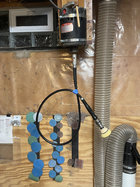
My solution was as follows. I had lost faith in my sump pump and bought a new one. I took the old sump pump motor (unfortunately it's 1750RPM) and mounted it on a board and hung it from the rafters. See the photo below. When hanging, it was essential to insulate the motor's vibrations with a bungee cord. I bought a five-foot long flex drive with a drill chuck on the end. Using it is a lot easier than with the hand drill. I use the tool rest to anchor the drive although Robbo Hippy's articulated rest might be better. The flex drive is the weakest part and if you sand gently they last for several years. Also the 3" pads are much harder on the flex drive than the 2" pads. I've initially used the sump pump switch but then switched to a foot switch and I'm now using a light switch mounted above the lathe.
In the photo you can see my velcro strips that hold my sanding discs. Depending on the wood, I can use them a couple of times before they are tossed. Since I normally turn green to finish, I've found that the Abranet grits work great on green wood since I can blow out the particles that fill in all the holes.

yep - one of two things that I can honestly say are a great buy at Harbor Freight (the 2hp dust collector is also great as a base for the Wynn filter and a cyclone). Been using their cheapest right angle drills for many years. Blow out every now and then and they keep on going.Me too. I have three of their old style, corded, right angle drills, with 1", 2", and 3" mandrels installed. Kind of like having enough chucks so you don't have to change jaws. My oldest is 12 years old and still going strong.
Sadly, they are no longer available.
So sorry to hear they’re not selling them any more…
I got this one today to see if it is easier on my mid-upper back than heavy sanding with my big heavy Dewalt drill: Bauer Angle Drillyep - one of two things that I can honestly say are a great buy at Harbor Freight (the 2hp dust collector is also great as a base for the Wynn filter and a cyclone). Been using their cheapest right angle drills for many years. Blow out every now and then and they keep on going.
So sorry to hear they’re not selling them any more…
I have just tried it out briefly today, so the jury's still out until I try it on a big bowl. It's a chunky tool to hold, but I'm hoping that holding it closer to the actual spinning sanding disk might give me more control (and thus fewer scuffs), as well as hopefully less fatigue and back soreness. The spinning disk is almost 10 inches away from the rear handle of the drill on the DeWalt, which I feel contributes to all of the above issues. I tried a Metabo sander at Arrowmont this summer and liked it pretty well mainly for this reason-my hands were much closer to the action.
I tried a cheapo Amazon pneumatic ROS that a friend loaned me and immediately disliked it because it was super-loud, and way too much vibration for my hands and wrists that once suffered from CTS. Plus it just seemed more aggressive. Maybe a nicer one like the Grex is better, though I haven't tried one.
As some others have mentioned on the sanding threads, getting better tool finishes sure cuts down on the dreaded sanding. We'll see how well I get along with the HF drill.
That is because you are so darn good!starting at no coarser than 180gt. Many times I can start sanding a tooled surface with finer grits than that.....240gt, or even higher at times.
I have a Milwaukee 55 degree, HF old 90 degree, and the HF Bauer 55 degree drills. I mostly use the
Bauer rather than the Milwaukee. The old HF 90 degree is used when a right angle drill is a better choice. For some reason I like the Bauer better. I went through two of the blue 55 degree drill in a short amount of time. The Bauer is about 18 months old, the HF 90 degree is about 5 years old, and the Milwaukee is about 7 years old.
Odie
Panning for Montana gold, with Betsy, the mule!
Thanks Bill......That is because you are so darn good!
I have a Milwaukee 55 degree, HF old 90 degree, and the HF Bauer 55 degree drills. I mostly use the
Bauer rather than the Milwaukee. The old HF 90 degree is used when a right angle drill is a better choice. For some reason I like the Bauer better. I went through two of the blue 55 degree drill in a short amount of time. The Bauer is about 18 months old, the HF 90 degree is about 5 years old, and the Milwaukee is about 7 years old.
I had one of those Milwaukee copies for a short time a dozen or so years ago. Off hand, I can't remember if it was blue. My impression of those is they are being made with cost-cutting measures that ultimately caused them to wear out sooner than the Milwaukee or Sioux brands. One thing that was a no-go for me was they didn't use a standard chuck, and required another key entirely.
-o-
Well my angle drill died. A friend of mine uses a right angle pneumatic die grinder and loves it so I bought one to try. I love it and will never go back to electric.
I use both. I find the electric does a better job on tearout and tool marks, but leaves a lot of scratches. I use the electric on the trouble spots, then switch to the pneumatic ROS for every other grit. The ROS doesn't leave scratches.
I've tried inertia sanders but don't see the value. it stands to reason that the sander spins at the same speed as the bowl or slightly less. I tried Woodturners Wonders ROS with 2" discs but the small size makes the RO action to little to really make a difference. I tried right angle drill sanders but the size of the head doesn't allow for them to work on anything small and when it does on larger items, a drill with a long mandril works just as well. I like my Dewalt 12V drill (lightweight) with a three pack of drill extensions of different lengthsInertia sanders seem quite popular. They are easy to make or fairly cheap to buy. Easy to use but not fast. Personally I quite like using them.
I did see a post on social media where a guy said they were a complete waste of time. He didn’t initially elaborate on why. When questioned he admitted that as professional turner he didn’t have time to use one, so he used a battery drill as a sander. Some asked why a professional turner was wasting his time posting on social media if his time was so short …
We had Professional Woodturner Martin Saban Smith do a demo at my club a few months ago. He went through a few grits with an Inertia Sander. It didn’t take long and the end result was impressive. He’s not the only Professional over here that uses them. Simon Hope also uses the product he sells. I guess though if you need to do a lot of sanding then a power sander is the way to go.

 hopewoodturning.co.uk
hopewoodturning.co.uk

Hope Pro Sander
Last edited:
Maybe. This months club competition is “Straight from the tool”, No sanding is allowed. Sadly I’ll be in holiday so I can’t enter or see the results.Everyone has to do sanding before applying finishes. I am interested in not only what is your primary sander e.g. battery powered drill, corded drill, or inertia sander, etc. but also, if you have experimented with different types of sanders, how did you choose your go to tool?
- Joined
- Apr 27, 2004
- Messages
- 9,306
- Likes
- 6,060
- Location
- Lakeland, Florida
- Website
- www.hockenberywoodturning.com
I've tried inertia sanders but don't see the value.
They have their place. I use them for hollow ornament balls.
They rarely leave sanding marks.
I do a lot of sanding off the lathe and they don’t do well then.
I use the sander from Woodturners wonders currently. I have done a lot of sanding by hand and still do if I am doing pens or spindles.
If you do large work, try the AirVantage from The Sanding Glove. The 3/32 orbit is ideal for sanding finish.
But I agree with Odie - hand sanding is the way to go. Better to focus on the abrasive (material, grit, backing) and the pad.
At the end of the day, the piece is a combination of surface, design, and species - when those, plus the mechanicals (thickness, moisture content) all come together, then the log is "all it can be" (pardon the bumper-sticker)
But I agree with Odie - hand sanding is the way to go. Better to focus on the abrasive (material, grit, backing) and the pad.
At the end of the day, the piece is a combination of surface, design, and species - when those, plus the mechanicals (thickness, moisture content) all come together, then the log is "all it can be" (pardon the bumper-sticker)
The cordless is handy for very light sanding, but my favorite is a made in Japan corded angle drill. They are beefy, compact, built like a tank and last forever. Several years ago, when things were moving to China, I bought an extra made in Japan one. Still on the shelves ... Makata DA3010F I like the paddle handle on it. They are still available new, but look around. Ebay has some like new ones. I used to use air sometimes, but after HVLP, space took my large air compressor.
Chef Tools are 40% off at the Harbor Freight parking lot sale this weekend.Well my angle drill died. A friend of mine uses a right angle pneumatic die grinder and loves it so I bought one to try. I love it and will never go back to electric.View attachment 66395
I’ve got a straight Die Grinder. Noisy and very cold in the hand in winter. I never use it anymore.Well my angle drill died. A friend of mine uses a right angle pneumatic die grinder and loves it so I bought one to try. I love it and will never go back to electric.View attachment 66395
I used to use sanding disks on angle drills, but now refuse to. For one thing, they make clouds of dust. They can sometimes have negative effects on the wood too. I haven’t even gotten the angle drill out of the drawer for years. I now use NRS then hand scrapers instead of the coarse sanding.
But I have three pneumatic random-orbital sanders, two pistol grip Grex sanders and one palm sander from Woodturners Wonders. I usually keep 2” and 1” disks on the Grexs and a 3” disk on the WW. I only use these with fine sandpaper since that’s all that’s needed after scraping. The random-orbital sanding action can be incredibly gentle with these.
What I like about the pneumatic ROSs is I can cut down the air pressure by a valve or by squeezing gently on the trigger and the sander runs at a very low speed. This is perfect for me. The one from Woodturners Wonders has a built-in valve.
It’s true that running these (and other rotating tools) wide open uses a lot of air! I am fortunate to have a 60 gal 5hp compressor which can keep up with them wide open but they might be bad for a smaller compressor.
JKJ
But I have three pneumatic random-orbital sanders, two pistol grip Grex sanders and one palm sander from Woodturners Wonders. I usually keep 2” and 1” disks on the Grexs and a 3” disk on the WW. I only use these with fine sandpaper since that’s all that’s needed after scraping. The random-orbital sanding action can be incredibly gentle with these.
What I like about the pneumatic ROSs is I can cut down the air pressure by a valve or by squeezing gently on the trigger and the sander runs at a very low speed. This is perfect for me. The one from Woodturners Wonders has a built-in valve.
It’s true that running these (and other rotating tools) wide open uses a lot of air! I am fortunate to have a 60 gal 5hp compressor which can keep up with them wide open but they might be bad for a smaller compressor.
JKJ

